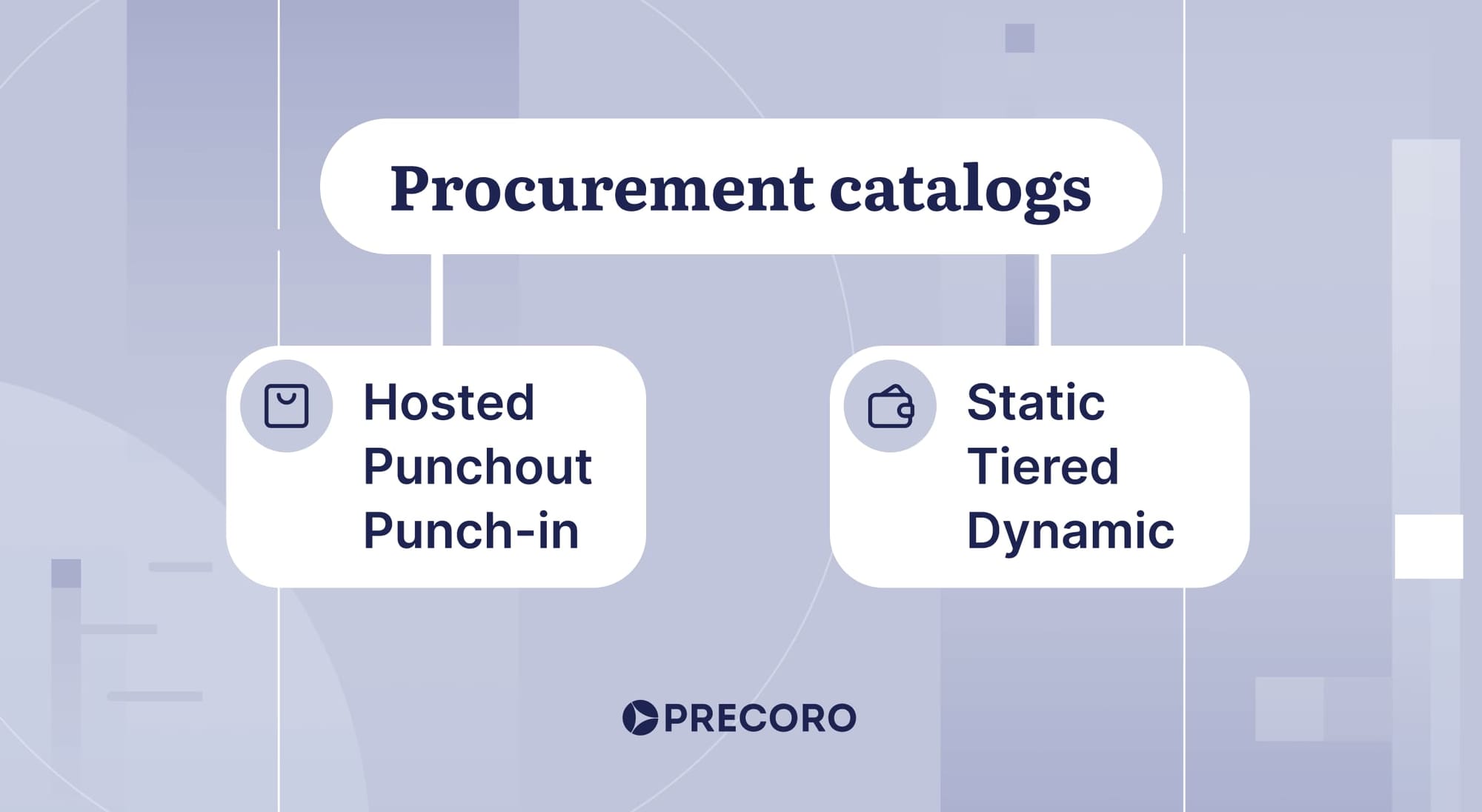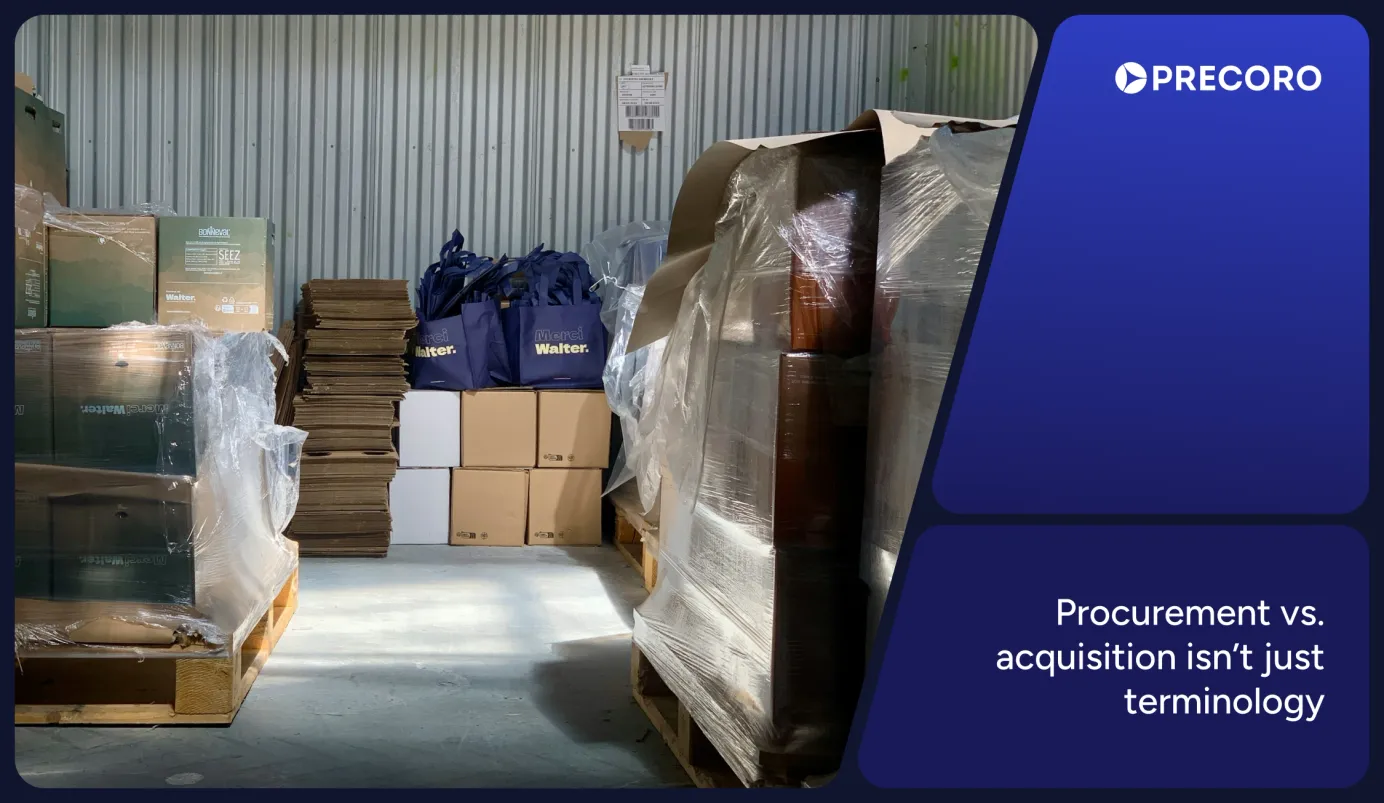
13 min read
Why a Well-Managed Procurement Catalog Is a Must for Cost Efficiency
Let’s discuss how businesses can drive purchasing efficiency and optimize costs by using software for procurement catalogs.
Efficient management of catalog items is one factor that distinguishes chaotic purchasing from organized procurement. Procurement teams that want to speed up the purchasing process and reduce errors while adhering to quality standards and budget limitations must have quick access to pre-approved items from vetted suppliers.
Catalog management in procurement is the process of keeping a centralized, organized, and up-to-date list of approved products and services from trusted suppliers. It makes purchasing faster and easier by giving employees access to pre-vetted options. Catalog management also ensures compliance with company policies and contracts, reduces off-contract spending, and improves pricing visibility.
Yet, catalog management itself can be a daunting and time-consuming task if done manually. In this blog post, we are going to define what a procurement catalog is, discuss what catalog management means, and go over some tips on how to administer these catalogs well.
What is Procurement Catalog Management?
Procurement catalog management is a process of assembling and maintaining a list of goods and services from vetted suppliers that are approved for the company employees to purchase from. Such a catalog is typically put together in the form of a digital library, and its management implies curating the content — that is, updating the items and their prices — and ensuring that the most recent catalog version is easily accessible to everyone involved in procurement.
With an up-to-date item catalog, procurement management is much more efficient, and purchasing teams can boost their work in the following ways:
- Simplify the purchasing process by having employees choose from pre-approved items
- Minimize delays by eliminating the need to review and approve every item
- Reduce purchasing errors by limiting the selection of items
- Improve budget accuracy and control costs by eliminating maverick spending
- Ensure compliance with organizational procurement policy
How Catalogs Vary
Before we go any further and dive deeper into the specific practices of efficient procurement catalog management, let’s talk about some typical types of the catalogs procurement teams use.
Procurement catalogs with supplier items come in different types, mostly varying in the frequency of updates and the way of transferring information. Typical types of the catalogs include the following.
Hosted
A hosted catalog typically refers to supplier items uploaded to the buyer’s procurement catalog software. The supplier would usually provide a file (for instance, in Excel, CSV, or XML formats) with the list of items and their descriptions for the buyer to upload to the system.
The file would be repeatedly updated, either by the supplier or at the buyer’s request. Such procurement catalogs are typically updated over standard periods of time — monthly or quarterly. Therefore, they are best suited for the suppliers who offer a standardized set of products to their customers and predictable pricing.
Punchout and Punch-in
For these two types of catalogs, the buying company integrates with the supplier catalog via dedicated Punchout or Punch-in interfaces. Instead of uploading the catalog as a file to its own procurement catalog system, the buying company is redirected to the supplier website.
With Punch-in integrations, the employee of the buying company starts going through the supplier’s items on the supplier’s website, adds these items to the shopping cart, and is then redirected to the buyer’s internal system.
With Punchout, the employee of the purchasing company starts by logging in to their internal procurement catalog software and is then redirected to the supplier’s website.
In both types of catalogs, procurement team members can browse the supplier’s catalog and select the items that are subsequently submitted back to the buyer’s procurement software. After returning to their own procurement software, the buyer processes the purchase order with the item information submitted via integration.
This type of procurement catalog is well-suited to suppliers with complex inventories and significant fluctuations in product availability and prices.
Static
This type of procurement catalog is somewhat similar to the hosted one but does not require repeated updates. It’s based on the “negotiate and forget” approach and is often used for long-term contracts with fixed pricing. In this case, such catalogs are also referred to as contract-based catalogs. However, a contract is not a prerequisite for establishing a static procurement catalog.
This type of catalog works best with standardized goods or services, where prices remain the same during the contracted period. Examples include maintenance services and office supplies.
Such static procurement catalogs can be periodically updated, but not necessarily regularly. Updates often occur together with contract renewals.
Tiered
In this type of catalog, the pricing structure is tiered, meaning that the item price depends on specific conditions, which should be outlined in the contract. Typically, it’s purchased volume or delivery location.
With tiered procurement catalogs, buyers can benefit from region-specific products and adjust to the varying demands of different locations. Such a catalog would, for example, fit retail companies with multiple branches that have different needs and purchasing power.
Dynamic
A dynamic procurement catalog is updated in real time (or at least significantly more often than a hosted catalog) and reflects the current price and availability of supplier items. It’s typically enabled by integrating the buyer’s procurement catalog system with the supplier system via API.
Such dynamic procurement catalogs are best suited for goods and services with volatile prices and availability when predicting conditions for the whole contracted period is complicated.
Supplier catalogs vary based on the industries, goods or services offered, contract terms, supplier relationships, and integration capabilities of the procurement catalog systems. Choosing the right type of procurement catalog depends on the organization’s procurement needs and the required frequency of updates.

The Challenges of a Traditional Way to Manage Procurement Catalogs
In many organizations, procurement catalogs are still managed in spreadsheets or separate external supplier systems. Catalog administration can become overwhelming if done manually or in autonomous systems. That’s especially risky for large and enterprise companies that deal with multiple vendors and suppliers across different industries, whether it's a construction business, renewable energy sector, hospitality, healthcare or other industries.
Manual catalog administration can lead to the following challenges.
Inconvenient and time-consuming updates
Updating the catalog can become a truly time-consuming task if one has to go through the information available in the separate supplier system and update catalog items manually. This is especially true if the suppliers frequently update product information and prices or add special offers.
Inconsistent and misleading information
As a result of a complicated procurement catalog updating process, organizations can end up with inconsistent and unreliable data. Out-of-date catalogs and information scattered across different systems not only lead to purchase order errors but can also cause significant production delays and financial losses.
Inefficient purchasing process
With manually — and therefore not always timely — updated or uncentralized procurement catalogs, company employees risk ordering outdated goods or services. A purchase order with outdated item information will not pass the approval workflow, delaying the whole purchasing process and keeping the procurement team busy with having to find the issue, fix it, and repeat the order.
Non-compliance issues
Without up-to-date information about the suppliers, vendors, and their offers in the procurement catalog, employees will have to look for solutions elsewhere. They might end up purchasing off-catalog items from unauthorized suppliers, risking non-compliance with the company policy or even regional or national laws.
Limited supplier visibility
When catalogs are managed in separate supplier systems, or if the information in the buyer’s procurement catalog software is outdated, it becomes difficult to compare suppliers and identify the best offer. The procurement team is left with the choice of guessing the best available offer or spending hours comparing the offers manually.
Implement Procurement Software to Enhance Catalog Management
Procurement software can address the abovementioned challenges by integrating and automating procurement catalog management. Companies that implement procurement software can employ smarter purchasing tactics and find the best suitable offer. Let’s see how exactly the procurement catalog management software can benefit an organization's purchasing team.
Centralized procurement catalogs
Modern procurement software serves as a single platform where all supplier catalogs are stored. This way, procurement teams don’t have to browse separate supplier portals, spreadsheets, or databases in search of the required item information. With a centralized procurement catalog repository, requesting employees and procurement teams can easily access up-to-date supplier offers and compare the items.
Easy navigation and filtering
Good procurement catalog software supports intuitive filtering and searching for the catalogs, making it easy for the procurement team to find the exact item they need. With customized filters, employees can easily navigate through the largest catalogs and narrow their searches based on supplier, price, availability, or any other criteria like sustainability or quality requirements. This way, the procurement team will be sure not to miss out on the best offer available on the market.
Real-time updates
One of the top features for which businesses like procurement catalog management software is the ability to update catalogs in real time and synchronize them with the vendors and suppliers, instead of having to undergo the tedious process of manual catalog updating. Procurement teams can configure modern procurement software to pull real-time information directly from the suppliers and, therefore, be sure to always have access to the relevant data.
Streamlined supplier cooperation
Efficient catalog management in procurement relies on collaboration with vendors and suppliers. The easier it is for the selling partners to exchange information with the buying partners, the faster transactions can happen. Top-notch procurement software provides vendors and suppliers with direct access to the platform (for instance, via the Supplier Portal in Precoro) to communicate with the procurement team and manage their product offerings.
By facilitating painless supplier catalog updates, organizations not only ensure up-to-date item information but also avoid errors and facilitate subsequent purchasing operations. This way, organizations can establish stress-free long-term relationships with their suppliers and eventually qualify for better offers.
Controlled spending and compliance
Organizations that centralize and administer their procurement catalogs in dedicated software are better able to ensure compliance with business procurement policies and budget limits. In procurement catalog management software, employees can only access items approved by the department heads or procurement managers. That significantly reduces the maverick spending and overpaying for the items found elsewhere. Procurement software can also notify employees if the necessary item is out of budget.
The procurement catalog system also allows tracking the purchasing history, which can be a good leverage while negotiating better deals or bulk discounts with the suppliers. In addition to this, when both selling and purchasing parties have easy access to the transparent catalog, it’s easier to negotiate long-term contracts with better conditions and actually ensure contract compliance.
Insightful reporting
When all the data about the procurement catalog items flows through the centralized system, it’s easier to analyze price development and availability tendencies. Modern automation solutions are capable of advanced reporting that offers insights into the supplier offers and spending patterns. These insights can be used to evaluate supplier performance and negotiate better deals with some of them.

Consider These Tips for Effective Catalog Management in Procurement
While procurement catalog management software is a powerful tool for managing catalogs, the final result's success ultimately depends on how well this tool is used. Here are key practices that we have found helpful over the years of working with procurement catalogs.
- Customize catalogs for different departments. Tailor procurement catalogs to the needs of different teams and display information depending on what’s relevant for any given department. For example, while the production unit depends on the delivery speed for materials, the back office team might prioritize high-quality support for the equipment they purchase. Make sure to include those criteria in the procurement catalog to make it easier for the users to filter out relevant products and select the best offer.
- Develop supplier collaboration. Take advantage of the procurement catalog management software accessibility and encourage suppliers to update item information directly in the software. It’s worth planning a few training sessions with your suppliers to introduce them to the software interface and functionality. This way, you can rely on suppliers to update the item information whenever something changes, and it’ll be easier for you to ensure that catalog data is accurate.
- Monitor performance. Even if not required for audit purposes, it’s helpful to track certain key metrics regularly in order to improve future purchasing performance. Some KPIs worth tracking are product availability, price fluctuations, catalog usage by employees, and supplier response time. This data can prove invaluable when designing requesting and purchasing workflows, analyzing supplier performance, and planning future procurement strategies.
- Utilize integrations to stay agile. Keeping up with price fluctuations is critical for error-proof and cost-efficient procurement. By utilizing integrations, you can stay up-to-date with the current supplier offer. Integration can be a game-changer in ensuring timely procurement catalog refreshing, for example, via recurring API updates. In addition to this, integrations like that of Precoro with Amazon Punch-in are a great way to bypass entering item details into a separate procurement catalog altogether and utilize information available directly from the supplier at any given moment.
Frequently Asked Questions
Catalog management in procurement involves organizing and maintaining a centralized list of approved goods and services. It simplifies purchasing, supports policy and contract compliance, and makes ordering faster and more efficient. Catalog management usually includes updating item details, pricing, and availability within a digital catalog.
Catalog management in procurement is critical for ensuring compliance with the organization’s procurement policies and other external regulations. With a well-managed procurement catalog, an organization can significantly reduce mistakes and discrepancies in purchase orders because employees purchase from approved suppliers at negotiated prices. This also enhances the cost-efficiency of the procurement process and helps prevent maverick spending.
The frequency of updating the procurement catalog depends on the supplier and product type. For suppliers in dynamic markets (for instance, office electronics), catalogs can be updated in real time or at least weekly. For markets with more stable pricing (for instance, chemicals for production), it might be enough to update catalogs monthly or quarterly. To ensure timely updates and eliminate the need to check for available updates, many organizations choose to integrate with suppliers and set up automatic synchronization.
Procurement catalogs mostly vary in the frequency of updates and the way of transferring information. Typical types of procurement catalogs include the following: hosted, Punchout and Punch-in, static, tiered, and dynamic.
Managing procurement catalogs manually poses a risk of outdated product descriptions and pricing information, purchase order errors, and inconsistent data across departments. This way, companies risk non-compliance with procurement policies and budget overdrafts. It is also time-consuming to update catalogs manually.
Procurement catalog management software allows organizations to centralize the catalogs in a single platform and automate the process of updating item information and pricing. The software then enforces the use of pre-approved suppliers and items across the company, therefore ensuring compliance with organizational policies. In addition to this, modern procurement catalog management systems also support direct integration with supplier platforms and enhance supplier communication.
Procurement Catalog Management for Efficient Purchasing
Catalog management in procurement is the practice of creating and maintaining a centralized list of pre-approved products and services from trusted suppliers. It speeds up purchasing, ensures compliance with company policies, and supports cost savings and operational efficiency.
Catalog management empowers businesses to simplify sourcing, speed up order fulfillment, and reduce backorders. By thoroughly evaluating and choosing the right suppliers, companies ensure consistent product quality while minimizing defects.
Catalog management also helps maintain balanced inventory levels, prevent stockouts, and solve common issues like overstocking or products approaching expiry. Beyond operational benefits, effective catalog management can reduce procurement costs, allowing businesses to offer more competitive prices to their customers.
Precoro is a solution that can help you take control of your catalog management. Ready to discover how? Contact us for a demo.









